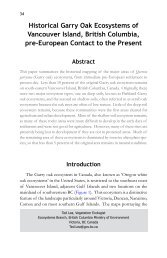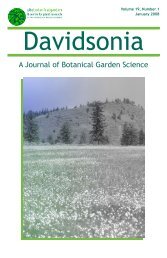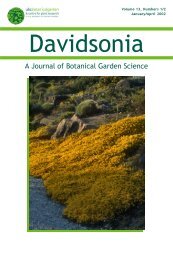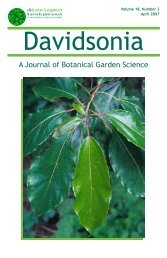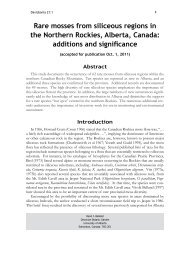pdf wkg Dav.14-14 - Davidsonia
pdf wkg Dav.14-14 - Davidsonia
pdf wkg Dav.14-14 - Davidsonia
Create successful ePaper yourself
Turn your PDF publications into a flip-book with our unique Google optimized e-Paper software.
<strong>Davidsonia</strong> <strong>14</strong>:4<br />
<strong>14</strong>7<br />
chilling requirements necessary to break dormancy. Even in climates that<br />
are optimal for present production, such as the Pacific Northwest, more<br />
plantings are to be found on heavier, poorly drained soils where Phytophthorainfected<br />
root rots can be devastating. The wide range of habitats, in which<br />
plants of the wild species flourish, indicates the presence of variability that<br />
can eventually meet the requirements of many of the diverse environments<br />
in which red raspberry culture now takes place or will take place in the future.<br />
Concomitant with the urgent need for more pest and disease resistances<br />
and wider environmental adaptations, unique market outlets for red raspberry<br />
fruit are being developed (Finn and Knight, 2002). There are few fruits that<br />
give rise to as many popular processed products. For example, raspberry<br />
juice by itself or in blends with other fruit such as cranberry, has become<br />
popular. Raspberry jam has always been popular and fruits processed into<br />
ice cream and yogurt and as whole “individual quick freeze” are equally<br />
popular. Consumers demand that fresh red raspberries be available for 12<br />
months of the year, just as strawberries and apples are. This has stimulated<br />
production in the Southern Hemisphere, where fresh fruit is air-freighted to<br />
the Northern Hemisphere from November through to April. Greenhouse<br />
and tunnel production for “out-of-season” fruit has also increased (Pritts et<br />
al., 1999). Recently there has been increased recognition of the health value<br />
of red raspberries, which have high levels of antioxidants or “nutraceutical”<br />
compounds such as anthocyanins, phenolics and ellagic acid, each of which<br />
is reported to be effective against the effects of the degenerative diseases of<br />
aging (Finn and Knight, 2002). Red raspberries figure prominently in<br />
advertisements for cereals and other products that are equated with healthy<br />
diets.<br />
In recent years, the Agriculture and Agri-Food Canada red raspberry<br />
breeding programme at the Pacific Agriculture Research Centre (PARC) has<br />
been using selections from previously unexploited populations of R. strigosus<br />
(Daubeny, 2002). Seedling populations of the species were obtained from<br />
sites in BC, the Yukon, Ontario, Quebec, Nova Scotia, Washington,<br />
Minnesota, Wisconsin, New York, and North Carolina. Most seedlings were<br />
initially screened for reaction to the aphid, Amphorophora agathonica, a vector<br />
of the raspberry mosaic virus complex. This complex can have a devastating<br />
effect on growth and fruiting of susceptible cultivars and the easiest way to<br />
control it is through vector resistance. Genes giving resistance to the aphid



